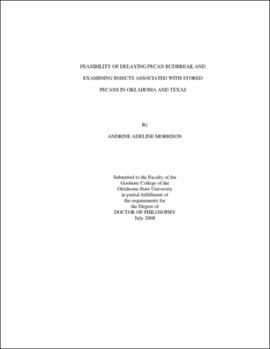| dc.contributor.advisor | Mulder, Phillip G. Jr. | |
| dc.contributor.author | Morrison, Andrine Adeline | |
| dc.date.accessioned | 2013-11-26T08:23:48Z | |
| dc.date.available | 2013-11-26T08:23:48Z | |
| dc.date.issued | 2008-07 | |
| dc.identifier.uri | https://hdl.handle.net/11244/6748 | |
| dc.description.abstract | Scope and Method of Study: A study was conducted to determine the feasibility of delaying pecan budbreak in spring using applications of Surround WP particle film and whitewash. Thirty trees (cultivar Pawnee) at Perkins Agricultural Experiment Station, Perkins, Oklahoma, were selected and randomly assigned to either of two treatments or untreated. Trees were sprayed twice with the assigned treatment in 2004 and 2005 and readings of temperature and budbreak stage were taken repeatedly until full leaf was achieved. Analysis was performed using Duncan's Multiple Range test of the GLM procedure in SAS statistical software. | |
| dc.description.abstract | A second study was conducted to determine reproductive capacity of stored insect pests in a no-choice test on pecans harvested in 2005. Insects were placed in 0.5 L mason jars filled with one of four pecan diets, wheat, or glass beads containing insects. Insect species employed were the moth Plodia interpunctella, and beetles Rhyzopertha dominica, Oryzaephilus surinamensis, Tribolium castaneum, and Cryptolestes ferrugineus. Fifty adults of each beetle species and 10 pairs of moths were released separately within jars and held at 28C, 60-70% RH, and 16:8 photoperiod for 2, 4, 6, and 8 weeks. Four replications of each insect-diet-interval combination were performed. Numbers of immatures and adults recovered were analyzed using FREQ procedure in SAS. | |
| dc.description.abstract | Thirdly, a trapping program was conducted to assess insect pest presence at 8 pecan storage facilities in Oklahoma and Texas. Two types of traps were baited with pheromone and/or nut oil and collected twice monthly for 1 year. Additionally, a questionnaire was distributed to pecan storage facility owners from these states to assess sanitation and insect pest problems. | |
| dc.description.abstract | Findings and Conclusions: No sustained differences in budbreak delay were observed between untreated trees and either treatments or between treatments. P. interpunctella, O. surinamensis, T. castaneum, and C. ferrugineus produced immatures on cracked and nutmeat pecan diets. P. interpunctella and O. surinamensis developed adults on cracked and nutmeat pecan diets. R. dominica did not reproduce on pecans and no insect could reproduce on glass beads. 11,653 insects representing 19 species were collected from pecan storage facilities and a relationship between insect populations and the presence of a retail component at pecan storage facilities was revealed in the survey. | |
| dc.format | application/pdf | |
| dc.language | en_US | |
| dc.rights | Copyright is held by the author who has granted the Oklahoma State University Library the non-exclusive right to share this material in its institutional repository. Contact Digital Library Services at lib-dls@okstate.edu or 405-744-9161 for the permission policy on the use, reproduction or distribution of this material. | |
| dc.title | Feasibility of delaying pecan budbreak and examining insects associated with stored pecans in Oklahoma and Texas | |
| dc.contributor.committeeMember | Payton, Mark E. | |
| dc.contributor.committeeMember | Dillwith, Jack W. | |
| dc.contributor.committeeMember | Smith, Michael Wayne | |
| dc.contributor.committeeMember | Phillips, Thomas W. | |
| osu.filename | Morrison_okstate_0664D_2833 | |
| osu.accesstype | Open Access | |
| dc.type.genre | Dissertation | |
| dc.type.material | Text | |
| dc.subject.keywords | pecan | |
| dc.subject.keywords | budbreak | |
| dc.subject.keywords | stored products | |
| dc.subject.keywords | plodia interpunctella | |
| dc.subject.keywords | oryzaephilus surinamensis | |
| dc.subject.keywords | tribolium castaneum | |
| thesis.degree.discipline | Entomology | |
| thesis.degree.grantor | Oklahoma State University | |
